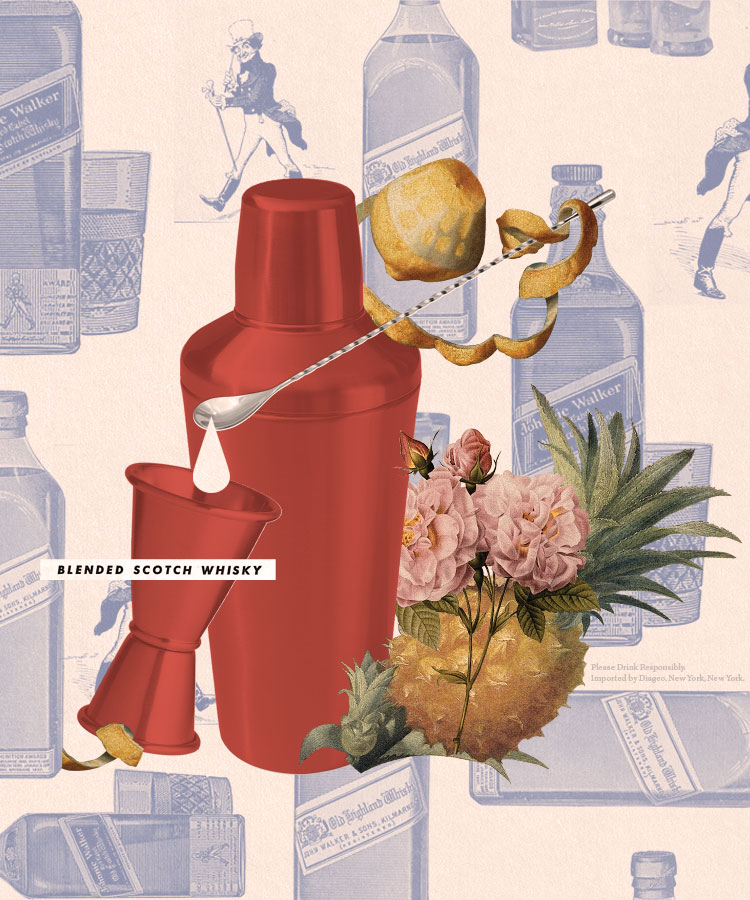This article is part of a cocktail history series, sponsored by Johnnie Walker. Discover more about classic Scotch cocktails here!
Sure it’s most famous in “and soda” and “on the rocks” incarnations, but around the world, great bartenders will tell you that blended Scotch — a source of both reassuring reliability and serendipitous new combinations — can work real magic in mixed drinks.
Made from both malt whiskies and grain whiskies, blended Scotch is a consistent and affordable spirit, without the greater range of idiosyncrasies (and much higher prices) associated with single malts. “The [flavors] are more harmonious and balanced than, for example, a clearly more ‘angular’ single malt,” says Orlando Marzo, Diageo’s World Class Bartender of the Year in 2018 and curator of the Melbourne Cocktail Festival.
And considering its affordability and near-ubiquity — unlike rare, only-in-Kentucky bourbons and exclusive cask expressions, most of us can easily get our hands on a bottle — blended Scotch is an easy jumping-off point for home bartending.
“Blends seem to be more open to new processes, experiments, and flavor combinations,” says Alex Kratena, bartender and co-owner of Tayēr + Elementary in London, pointing to a broader flavor spectrum.
In that spirit, we talked to a handful of bartenders from around the world to get their tips on mixing drinks with blended Scotch.
All will agree that tasting a Scotch on its own, maybe with a few drops of water, is the best way to assess its inherent flavor characteristics. To get a grasp on how a specific bottling will work in cocktails, however, Felix Allsop, bar manager at The Everleigh, an award-winning bar in Melbourne, suggests stirring it into a familiar recipe like an Old Fashioned, a Rob Roy, or a Manhattan. “Then taste and decide where to tweak,” he says.
Let these initial impressions steer where to go next, adding ingredients that will complement the base spirit. “We often work to accentuate flavors and nuances that are already in the blend.” Kratena says, noting a spectrum that can range from light, delicate, and elegant to rich, robust, and smoky.
Once this baseline understanding is in place, then you can start calling on other flavor boosters to really draw out the character of the Scotch, such as simple syrup infused with fresh herbs or dried spices or fruit tossed in your mixing tin.
In this vein, Eduard Ondracek, a bar consultant and co-founder of Bonvivant’s in Prague, Czech Republic, recommends variations of red fruit and minty herbs with a blended Scotch in julep-style cocktails, suggesting such combinations as raspberry and mint, strawberry and basil, or even red currants and parsley.
When compared with North American whiskies, Josh Lindley of Bartender Atlas and the Toronto Cocktail Conference has noticed that blended Scotch offers more nuanced floral and salty flavors, opening up the potential for playing with different sugars —brown, cane, even molasses or pomegranate syrups — as well as a distinct canon of bitters.
“I find that citrus-forward bitters are a fun way to accentuate a lot of the more delicate features of blended Scotch,” Lindley says. “Lemon and grapefruit bitters spring to mind.”
Depending on the spirit, there can be plenty of leeway when it comes to flavor combinations. Allsop loves adding pineapple, of all things, to Scotch cocktails. And at the Old Punch Bowl, a storied tavern in Dublin, head bartender Karl McGowan boldly recommends freshly ground pepper as an accompaniment to blended Scotch, inspired by Eastern Europe’s tack with vodka.
“Got a blended whisky with spicy undertones? Try it. I can’t guarantee you’ll like it, but you could well be pleasantly surprised,” McGowan says.
Sticking to a simple highball construct (Scotch plus soda water), Marzo says he doesn’t have to tinker too much to get great results. “My favorite choice for a Scotch highball is to add a hint of citrus and a syrup made from quince,” he says.
For those of us without homemade quince syrup in the fridge, Ondracek says that even grocery store mixers, like cola, ginger beer, and tonic water, can still make for a great Scotch cocktail. Beyond the soda aisle, he finds other inspirations, too. “You can use raspberry lemonade, look at elderflower lemonade, look at these flavored tonics. Imagine a tonic with rose water. That will go great with any type of blended Scotch,” Ondracek says.
“With some of the single malts, that combination might not be that successful, because they’re so particular,” he says. “But the idea of blended Scotch is: easy to drink, easy to mix.”
This article is sponsored by Johnnie Walker. Keep walking.
